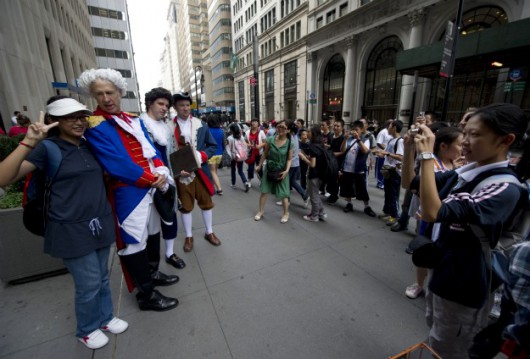 Minutes after arriving by bus at an outlet mall in Cabazon, Calif., a dozen or so Chinese tourists hustled out to buy luggage that they planned to stuff with high-end clothes, shoes and bags.
Minutes after arriving by bus at an outlet mall in Cabazon, Calif., a dozen or so Chinese tourists hustled out to buy luggage that they planned to stuff with high-end clothes, shoes and bags.
But not Guoshing Cui, a Samsung supervisor from Guangzhou. He made a beeline for the Coach store, where he picked out three expensive handbags. He paid more than $800 from a wad of $100 bills.
The bags were gifts for family and friends in China, where Coach goods sell for two to three times the price in the U.S. ?It?s a smart move,? he said of his purchases.
That kind of power shopping has made the Chinese tourist the highest-spending overseas visitor to the U.S. and one of the most valued customers for U.S. outlet malls, shopping centers and tour bus operators.
Chinese tourists spend an average of $2,932 per visit to California, compared with $1,883 for other overseas visitors, according to the latest statistics by the U.S. Office of Travel and Tourism Industries. A big chunk of their spending ? about 33 percent ? goes for gifts and souvenirs.
?What we know about Chinese visitors is they don?t like to lay on the beaches,? said Ernest Wooden Jr., president of the Los Angeles Tourism and Convention Board. ?What they do like is shopping.?
The outpouring of Chinese money helped set a record for spending by foreign visitors to the U.S. ? $168.1 billion in 2012, according to federal officials.
China?s relatively strong economy and its growing middle class means more Chinese citizens have money to travel and spend, according to tourism experts. The middle class in China numbered 247 million people in 2011, or 18 percent of the population, and is projected to grow to more than 600 million by 2020.
Spending by Chinese travelers has grown so fast in the past few years that it has surpassed the per capita outlays of other high-spending visitors, including travelers from Japan, Australia, Brazil and South Korea.
The customs and unique characteristics of the local economy shape how foreign visitors spend their time and money when visiting the U.S.
Australians, for example, share a similar culture with the U.S. and are more likely than other overseas travelers to visit museums, art galleries and historical sites.
Click here to read more.
Source: Hugo Martin (2013). Chinese tourists power-shopping in U.S., Seattle Times?http://seattletimes.com/html/travel/2021115604_chinesetouristsxml.html published Jun 03, 2013. Viewed Jun 04, 2013.

